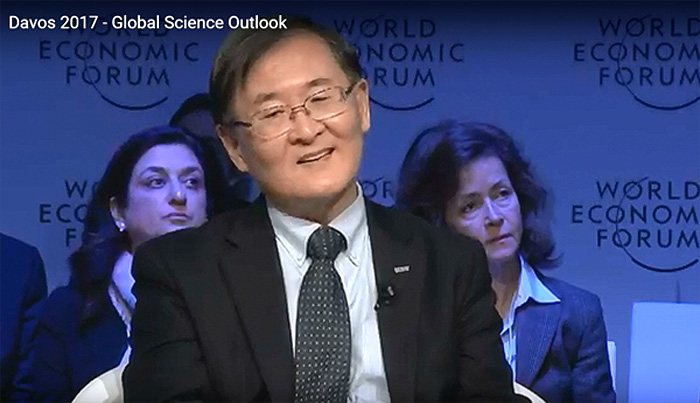people

President Sung-Mo Kang of KAIST participated in the World Economic Forum’s Annual Meeting January 17-20, 2017 in Davos, Switzerland.
On January 20, President Kang joined the Arena discussion on the outlook of global science in the year ahead with a group of distinguished scientists, including the Director of the US National Science Foundation, France A. Córdova, and the Editor-in-Chief of Nature, Philip Campbell.
Under Dr. Campbell’s moderation of the session, the panelists introduced their perspectives on 2017 and engaged in free discussions among themselves and with the audience.
President Kang began his talks on four major technological trends that have caught much of our attention in recent years, which he called “ICBM.” The “I” stands for the Internet of Things (IoT), “C” for cloud computing, “B” for brain, in other words, cognitive computer science such as artificial intelligence, and “M” for mobile technology that has been widely applied to unmanned ground vehicles and drones.
He noted the emergence of brain research as one of the most exciting fields in the coming years, and accordingly, we will learn more about its functions and develop promising results in treating brain-related diseases, i.e., a nanoscale memory chip being inserted into a patient suffering from dementia for targeted therapy.
President Kang also mentioned the role of higher education in the era of the Fourth Industrial Revolution, for example, how to foster scientists and engineers to responsibly meet with the challenges anticipated in today’s rapidly changing technological environments. He said that robots would replace many jobs, and it is important to come up with real solutions for such changes.
Lastly, President Kang stressed that the scientific community should continue its efforts to communicate with the public, accurately informing them of key scientific issues and offering opportunities to hold public discussions and debates that have greater influence over society. He presented a case of Korea’s latest outbreaks of Avian Influenza that resulted in destroying hundreds of thousands of infected chickens to prevent the spread of the disease, and highlighted the need for maintaining a strong communication channel between science and the public.
The full list of the participating panelists included Sung-Mo Steve Kang, President, KAIST; Marc N. Casper, President and Chief Executive Officer, Thermo Fisher Scientific, USA; France A. Córdova, Director of the National Science Foundation (NSF), USA; and Fabiola Gianotti, Director General of the European Organization for Nuclear Research (CERN), Geneva, Switzerland.
To watch the entire discussion, please go to https://www.youtube.com/watch?v=bF-joYnyYa0.
-
research Simultaneous Analysis of 21 Chemical Reactions... AI to Transform New Drug Development
< Photo 1. (From left) Professor Hyunwoo Kim and students Donghun Kim and Gyeongseon Choi in the Integrated M.S./Ph.D. program of the Department of Chemistry > Thalidomide, a drug once used to alleviate morning sickness in pregnant women, exhibits distinct properties due to its optical isomers* in the body: one isomer has a sedative effect, while the other causes severe side effects like birth defects. As this example illustrates, precise organic synthesis techniques, which selectivel
2025-06-16 -
event KAIST Holds a Ceremony to Declare their Renewed Commitment for Ethical Management
KAIST held a ceremony to declare their renewed "Commitment for Ethical Management" to raise awareness and solidify the commitment its members to faithfully fulfill ethical responsibilities and duties. Last March, the university established the 'Special Committee for Ethical Management,' chaired by the Provost, and under the leadership of this committee, a new 'Code of Ethics' and 'Code of Conduct' were prepared, containing ethical standards that members must adhere to across all areas of educ
2025-06-16 -
research “One Experiment Is All It Takes”: KAIST Team Revolutionizes Drug Interaction Testing, Replacing 60,000 Studies
A groundbreaking new method developed by researchers at KAIST and Chungnam National University could drastically streamline drug interaction testing — replacing dozens of traditional experiments with just one. The research, led by Professor Jae Kyoung Kim of KAIST Department of Mathematical Sciences & IBS Biomedical Mathematics Group and Professor Sang Kyum Kim of Chungnam National University's College of Pharmacy, introduces a novel analysis technique called 50-BOA, published in Natu
2025-06-16 -
research High-Resolution Spectrometer that Fits into Smartphones Developed by KAIST Researchers
- Professor Mooseok Jang's research team at the Department of Bio and Brain Engineering develops an ultra-compact, high-resolution spectrometer using 'double-layer disordered metasurfaces' that generate unique random patterns depending on light's color. - Unlike conventional dispersion-based spectrometers that were difficult to apply to portable devices, this new concept spectrometer technology achieves 1nm-level high resolution in a device smaller than 1cm, comparable in size to a fingernail
2025-06-13 -
research KAIST Predicts Diseases by Early Detection of Aging Signals in Liver Tissue
- KAIST-KRIBB Develops ‘FiNi-seq’ Technology to Capture Characteristics of Fibrotic Microenvironments Accumulated in Liver Tissue and Dynamic Changes of Early Aging Cells - Elucidation of the Spatial Ecosystem of Aged Liver Tissue, where Reprogramming of Senescent Cells and Immune Exhaustion Progresses, at the Single-Cell Genome and Epigenome Levels < (From left) Professor Jong-Eun Park of KAIST Graduate School of Medical Science and Engineering (GSMSE), Dr. Chuna Kim of K
2025-06-12